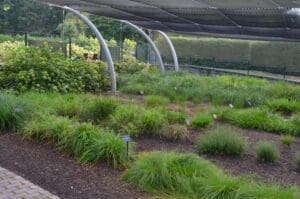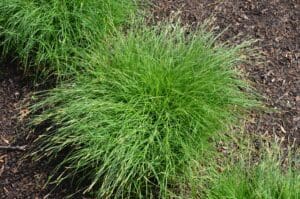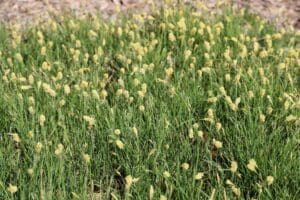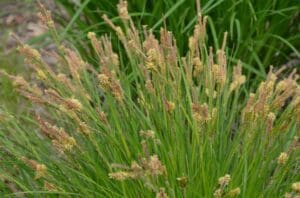

Mt. Cuba Center’s Sam Hoadley, right, in the center’s trial garden.
Mt. Cuba Center’s latest plant research report offers home gardeners some options for turf grass-like plants that can be moved and work well in full shade or full sun.
A five-year study of Carex plants, also known as sedges, found that many of the 70 tested were remarkably resilient.
“Some of the biggest surprises were just the adaptability of these plants,” said Sam Hoadley, Mt. Cuba Center’s manager of horticultural research. “We really kind of put them through their paces.”


Sam Hoadley
Mt. Cuba’s trial garden uses middle-of-the-road average garden soils, he pointed out.
The average home gardener should consider sedges as a tough, adaptable and versatile group of plants that will also provide food and shelter for wildlife, he said.
In addition to providing ground cover like grass, they can be massed in large groups.
“Several different species kind of mixed together is really great,” Hoadley said. “It’s a very interesting look that gives you lots of different textures from plants with very fine textured foliage and plants with very coarse textured foliage. Two of the different kinds of foliage really contrast beautifully when they’re planted together.”
One Carex — C. stricta — is figuring into a project that Mt. Cuba is working on with the state of Delaware to help expand bog turtle habitats. Bog turtles, the smallest turtles in North America, are imperiled through their range, Hoadley said.
“They like to nest in the crown of this specific species of Carex, which grows in very wet boggy habitats,” he said.
Mt. Cuba has been propagating the plants and then giving them to the state, which as been planting them in the turtles’ habitat.
“They’re actually seeing the bog turtles using those plants as nesting sites,” he said. “There’s been successful collections of eggs that have hatched from those reintroduced plants. It’s just a really cool story about conservation in action and showing how some of these conservation initiatives really do work.”


Carex plants being tested under shade in Mt. Cuba Center’s Trial Garden. Photo by Mt. Cuba.
For home gardeners, the many varieties of Carex offer lots of choices and looks.
“While we were mostly evaluating the Carex from an ornamental perspective, we were telling people, “You know, these plants look good. They’re going to have a presence in your garden for a long period of time. They add texture, and they’re going to cover ground suppress weeds,” he said.
Mt. Cuba didn’t evaluate the plants’ effect on pollinators because they are wind pollinated, unlike the plants in a recent hydrangea trial. During that one it was easy to where where bees flocked, which was to lace caps.
“Carex are providing habitat for wildlife while they’re providing cover,” Hoadley said. “They’re also providing a food source in the form of their leaves. They are actually host plants for a number of caterpillars, as well as producing seeds that are eaten by birds and small mammals.
“So there is ecological value. It’s harder to to measure, but a lot of those ecological interactions will actually happen in your home garden as we saw them happening in our trial garden.”
That makes Carex a strong possibility for anyone focusing on the long-term sustainability of a garden, he said.
65 sedges species tested
Mt. Cuba tested included 65 species, including five native to the Mid-Atlantic, many from the entire East Coast and even some from the Midwest.
“The diversity of the genus is outmatched only by the wide spectrum of habits in which they grow—from shady wetlands to coastal dunes, you can find a Carex to grow and thrive there.” he said.
One of the trial’s most interesting takeaways was how many of the species that are usually considered southern plants did well in Delaware’s generally cooler climate.
“It’s kind of a mixed bag, but we definitely did have some southern species and some of them did really well,” he said.
Mt. Cuba’s report on Carex ranks the species and cultivars based on plant vigor and foliage quality in both sun and shade locations.
The report focuses on 16 of the 70 cultivars that it trialed and names Carex woodii, or Wood’s sedge, was the top performer in the trial.
It excels in sun and shade and has a low-growing, slow-spreading habit like C. pensylvanica, but forms a denser mat of foliage, and is therefore superior to suppressing weeds, the report said. It also offers a carpet of straw-colored flowers from April to May.
The report specifically details which sedges work in dry or moist-to-wet soils.
It also says that small- to medium-sized Carex with fine-textured foliage gave the aesthetic most closely associated with that of a traditional lawn.
Sspecies with horizontally growing underground roots show potential to fill in gaps within a lawn, as well as require fewer plants when installing a Carex lawn from scratch, it said.
DELAWARE HISTORY: Iron Hill adds African American History Trail
Hoadley said come sedges are available at local nurseries, usually as a plug that will spread once planted. He recommends checking with your local garden center first and if you can’t find what you wanted first, seek them online.
One site he suggests is Izel Native Plants.
Izel fills an important function for people who don’t have access to wholesale accounts because it sells plants from larger growers, he said.
“So you’re able to buy large quantities of things like plugs of Carex and other perennials as a homeowner without a wholesale license or agreement,” he said.
Hoadley also suggests looking at nurseries such as Prairie Moon Nursery, which sells Carex seeds.
“That’s a great way to add a lot of Carex to your home garden for a relatively inexpensive price,” he said. “It just takes a little bit of extra time, but it’s well worth doing.”


Betsy Price is a Wilmington freelance writer who has 40 years of experience, including 15 at The News Journal in Delaware.
Share this Post






